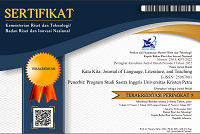Code-Switching Used by Mrs. EE, the Owner of N Store, to Her In-Store Customers
DOI:
https://doi.org/10.9744/katakita.11.2.240-246Keywords:
Corporate Governance, Board Structure, Board Size, Audit Committee Size, Board Diversity, Intellectual Capital Disclosure, Voluntary Disclosure, Earnings ManagementAbstract
This study utilized the theoretical frameworks presented by Wardhaugh (2006) and Appel and Muysken (2005) to analyze the kinds and functions of code-switching utilized by Mrs. EE, the owner of N Store, when communicating with customers. This study utilized a qualitative approach that examined Mrs. EE’s use of code-switching in her speech. The study’s results showed that Mrs. EE utilized both situational and metaphorical kinds of code-switching. She utilized various code-switching functions namely referential, directive, expressive, phatic, metalinguistic, and poetic. The study has concluded that Mrs. EE’s use of code-switching may be influenced by various factors such as her linguistic background, the context of the conversations, and her relationship with her customers.
References
Appel, R. and Muysken, P. (1987). Language contact and bilingualism. Edward Arnold.
Appel, R., & Muysken, P. (2005). Language contact and bilingualism. Amsterdam Academic Archive.
Wardhaugh, R. (2006). An introduction to sociolinguistics (5th ed.). Blackwell Publishing.
Downloads
Published
Issue
Section
License
Authors who publish with this journal agree to the following terms:- Authors retain copyright and grant the journal right of first publication with the work simultaneously licensed under a Creative Commons Attribution License that allows others to share the work with an acknowledgement of the work's authorship and initial publication in this journal.
- Authors are able to enter into separate, additional contractual arrangements for the non-exclusive distribution of the journal's published version of the work (e.g., post it to an institutional repository or publish it in a book), with an acknowledgement of its initial publication in this journal.
- Authors are permitted and encouraged to post their work online (e.g., in institutional repositories or on their website) prior to and during the submission process, as it can lead to productive exchanges, as well as earlier and greater citation of published work (See The Effect of Open Access).














